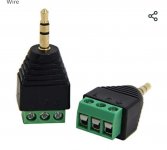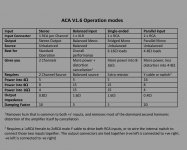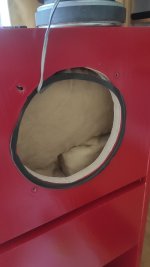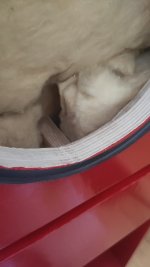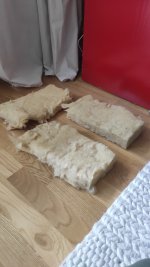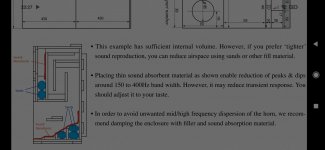But consider that you will never likely be using more than a watt. So even with an 8R you will only load the R with 1w.
dave
dave
Hmm, in retrospect probably should have stated it was referenced to Dcr, so not sure ATM WRT an HE audio circuit and no useful experience since the wire wound resistors I had easy access to (cheap/free) were typically rated in the hundreds of watts.
Thanks, that's what I speculate as well, but asking just in case there is a potential for "spikes" that i dont see.. But clearly if these speakers can play reasonably loud powered by a measly battery powered headphone amp like the chord Mojo (less than 1w RMS), than it should be plenty.But consider that you will never likely be using more than a watt. So even with an 8R you will only load the R with 1w.
dave
Looking forward to any other recommendations regarding driving fullrange speakers with headphone amps. I think the value proposition is quite excellent. A dac, dsp if needed and amplification all integrated in one device. The likelyhood of this being far more optimized than separates is substantial imo.
Hej, I will also be testing driving fostexes directly from a head-amps 3.5mm jack (Mojo2). I ordered this 3 terminal adapter and plan to bolt wires directly, joining the negatives at the terminal). Does anyone see any potential problem with this, or should it work fine?
Attachments
Small update, I'm driving now fostex horns directly from Mojo 2 dac/headphone amp. While the main FR imbalance is still present, what is fascinating is just how well this works. Skipping the dedicated amp unearthed layers of detail, space and even dynamics. Even the peakiness of the upper band is not that bothersome and i can listen louder than I ever did without "fatigue". Huge and deep sound, from a pocket battery device, quite remarkable.
Aside from a fpga controlled dac, there is a uber simple single ended class A amp in there, consisting only of a few discreete components. Even has a "lossless" (reportedly) dsp builtin, which I will be testing in the comming weeks to see how it deals with the peaky top.
Now what i need to find is a curent-drive equivalent. Any tips? Are there any headphone amps which are current drive?
Aside from a fpga controlled dac, there is a uber simple single ended class A amp in there, consisting only of a few discreete components. Even has a "lossless" (reportedly) dsp builtin, which I will be testing in the comming weeks to see how it deals with the peaky top.
Now what i need to find is a curent-drive equivalent. Any tips? Are there any headphone amps which are current drive?
Found nothing that would fit the bill Sir. But ACA kits are back in stock so I ordered one today, which will be my first forray into building an amp. Im excited. Im sure I can get good advice from kind and capable gentlemen on this forum🙂 Will be moving any further inqury to appropriate threads, but please feel free to comment on this choice. I first had 2 in cart, but decided to go for one to start with. It should be plenty of power, but wonder if dual mono setup has considerable SQ advantages over stereo on such a high sensitivity loudspeaker.
Thanks again!
Thanks again!
Appreciate the response, but what do you mean by "x-amp style pushpull"?A bridged/balanced ACA is sort of an X-amp style PP amp and is quite different onically than a single ACA.
On the newest one it is a switch.
dave
In other words, is the doubling of Rout with dual balanced mono mode (which makes it "PP") worth it over keeping SE operation with a single stereo amp?
Im confused a bit, is than dual unbalanced (bridged) mono still SE?
Im confused a bit, is than dual unbalanced (bridged) mono still SE?
In other words, is the doubling of Rout with dual balanced mono mode (which makes it "PP") worth it over keeping SE operation with a single stereo amp?
Im confused a bit, is than dual unbalanced (bridged) mono still SE?
They are different. An ACA can be operated in Stereo (SE), ParallelMono (SE), and Bridged/balanced (sorta PP, SEs run independently out of phase with no feedback gives you 2nd order cancelation,)
The ParallelMono feeds both inputs the same signal and the speaker connections are parallel, red to red, black to black. In terms of load happy with 4Ω comfortable with 8Ω
Bridged/Balanced Mono feeds each side with an opposite phase signal, the output is taken for the 2 hots (black terminals), nothing to the red. Happiest into 16Ω, happy with 8Ω.
How much power? 16w into the loads above. Less outside that range.
The stereo amp is 8W. Happy into 8Ω, comfortable at 4Ω (still 8w).
Stereo has about 0.8 Ω Rout, Parallel half that, bridged/balance doubles putting it in simialr range to typical SE tube amplifiers.
So you have to look at your application and figure out what should work best, and then you will probably buy a pair (they are soo cheap) and try everything and let your ears decide.
dave
Thanks Dave.
My belief is that the advantage of high sens speakers is that you can meet the power demands with a pure SE amp, which is "always" preferable to using any sort of PP (quasi or actual). Am I wrong? Or is it a matter of taste (due to cancelation of 2nd harmonic, which some might prefer?
In 2xACA case, despite PP operation, amps still run in pure class A, so crossover distortion is non-existent, correct? Perhaps than this is similar to the SET vs OTL debate.
One last thing. I'm having trouble distingushing between the balanced and unbalanced (bridged) operations. In the chart below, unbalanced(bridged) is specified as "single ended". Does that really mean quasi-PP, where one amp is in reverse phase, but each technically operating in SE mode?
My belief is that the advantage of high sens speakers is that you can meet the power demands with a pure SE amp, which is "always" preferable to using any sort of PP (quasi or actual). Am I wrong? Or is it a matter of taste (due to cancelation of 2nd harmonic, which some might prefer?
In 2xACA case, despite PP operation, amps still run in pure class A, so crossover distortion is non-existent, correct? Perhaps than this is similar to the SET vs OTL debate.
One last thing. I'm having trouble distingushing between the balanced and unbalanced (bridged) operations. In the chart below, unbalanced(bridged) is specified as "single ended". Does that really mean quasi-PP, where one amp is in reverse phase, but each technically operating in SE mode?
Attachments
... with a pure SE amp, which is "always" preferable to using any sort of PP (quasi or actual). Am I wrong?
It is wrong. Each has its advantages and EXECUTION plays a huge role.
My best 2 amps are a Firstwatt SIT-3 (SE) and a diy PP EL84 triode Class A PP (3.2 w at clipping). They are closer than they are different.
Or is it a matter of taste (due to cancelation of 2nd harmonic, which some might prefer?
That certainly plays a big role. Speakers make a huge contribution to the amplifier’s performance as well.
You said high efficiency, but it should be noted that many high efficiency designs have ugly impedance curves (Klipsch is a stangout here), often suggested due to the sensitivity spec (pretty much shown to be about 3dB higher than reality), are not really suited to high Rout amplifiers (typified by SE amplifiers) due to the large freuency swings caused by the impedance curve.
In 2xACA case, despite PP operation, amps still run in pure class A, so crossover distortion is non-existent, correct?
Yes.
SET vs OTL debate.
OTL can be SE but is usually PP. This is really about swapping a singlr output tube and a transformer vrs a ton of tubes (all different) in parallel without a transformer.
To get OTL one sacrifices simplicity.
One last thing. I'm having trouble distingushing between the balanced and unbalanced (bridged) operations.
The way they are achieved is different, the result is the same (so i consider thenm the same), in theory balanced should be a bit better, but...
"In theory, there is no difference between theory and practice. But, in practice, there is."
Does that really mean quasi-PP, where one amp is in reverse phase, but each technically operating in SE mode?
That will require someone more knowledgable than me to answer, sort of, AFAIK, it is when viewed at the most simplistic view.
In theory the same should be doable with any SE stereo or PP amp.
dave
Thanks for this expansive answer dave, really helps alot! The kit has landed and some tools on the way, I'm excited to get going🙂
I have peeked inside the cabinets today and found copious amounts of mineral wool right behind the driver. It was partially even covering the upper port of the horn. From what I've gathered (see link): ), this might be a bit much, stifling even lower frequencies. I def. think the speakers play a bit on the lean side as it is.
https://diyaudioprojects.com/Speakers/Fostex-FE206En-Back-Loaded-Horn-Speakers/
I have done a quick test without the wool in one speaker, without any measurements, I could notice more sound came out, but indeed it was less refined/more cacophonic. What's your take on it guys? If I was to redo dampening, what and how much should I start with? I'm think of also trying dampening the driver chassis as in the article above, but the writer hasn't reported on the results, so not sure if its worth it?
Also the wire to the driver seems quite a bit thicker than suggested (ca. 20g compared to 30g in the article). Does it make sense to try a thinner wire?
Thanks! Alex
https://diyaudioprojects.com/Speakers/Fostex-FE206En-Back-Loaded-Horn-Speakers/
I have done a quick test without the wool in one speaker, without any measurements, I could notice more sound came out, but indeed it was less refined/more cacophonic. What's your take on it guys? If I was to redo dampening, what and how much should I start with? I'm think of also trying dampening the driver chassis as in the article above, but the writer hasn't reported on the results, so not sure if its worth it?
Also the wire to the driver seems quite a bit thicker than suggested (ca. 20g compared to 30g in the article). Does it make sense to try a thinner wire?
Thanks! Alex
Attachments
I would not expect the need of any damping in the Fostex factory horn (the 208 one works best with FE206).
dave
dave
Not too sure about it, they do recommend a "thin" sheet in their official doc (see bellow). I do think its rather overdone in my example, wondering what material and how much would be "thin". Can i just use some 5mm felt sheet, would that work?I would not expect the need of any damping in the Fostex factory horn (the 208 one works best with FE206).
dave
When you say 208, you mean the taller/slimmer one they recommend for the fe208 sigma?
Attachments
- Home
- Loudspeakers
- Full Range
- Best Amp & cables for Fostex FE206En BLH
